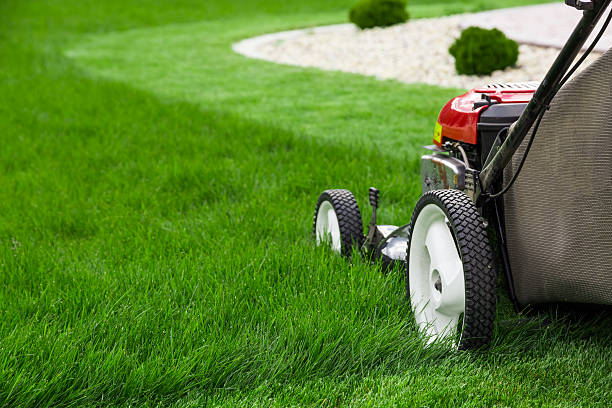Maintaining a lush, green front yard is the pride of many homeowners. However, improper mowing techniques can do more harm than good, leaving your grass stressed, brown, and patchy. In this guide, we will walk you through the steps to mow your lawn effectively while ensuring the health and beauty of your grass.

1. Know the Ideal Mowing Height
The first step to a pristine lawn is understanding the ideal height for your grass type. Different grass species have different optimal heights. For example, cool-season grasses like Kentucky bluegrass should be kept at 2.5 to 3.5 inches, while warm-season grasses like Bermuda grass thrive at 1 to 2 inches. Mowing at the correct height promotes deeper root growth, which makes your lawn more drought-tolerant and resistant to weeds and pests.
2. Mow When the Grass is Dry
Always mow when your grass is dry. Wet grass can clog your mower, resulting in uneven cuts and clumps of wet clippings that can smother your lawn. Additionally, mowing wet grass can lead to slippery conditions, increasing the risk of accidents. Wait until the morning dew has evaporated or after a rainstorm for the grass to dry out before mowing.
3. Get a Quality Lawn Mower
Investing in a quality lawn mower is key to maintaining a healthy lawn. Getting a new lawn mower with sharp blades will ensure clean cuts, reducing the chance of tearing and damaging the grass blades. Torn grass is more susceptible to diseases and pests, which can quickly ruin your front yard. Regularly check and maintain your mower to keep it in optimal condition. This includes sharpening the blades at least once a season and checking the engine and wheels to ensure everything is functioning correctly.
4. Follow the One-Third Rule
One of the cardinal rules of lawn mowing is the one-third rule. Never remove more than one-third of the grass blade length in a single mowing session. Cutting more than this can stress the grass, leading to weakened roots and increased vulnerability to diseases. If your grass has grown too tall, gradually reduce its height over several mowings rather than cutting it back drastically all at once.
5. Vary Your Mowing Pattern
Switch up your mowing pattern each time you mow. Mowing in the same direction every time can cause the grass to lean and compact the soil, leading to ruts and uneven growth. By varying your mowing pattern, you encourage the grass to stand upright and ensure an even cut. This practice also helps prevent soil compaction, promoting better water and nutrient absorption.
6. Leave Grass Clippings on the Lawn
Many homeowners believe that bagging grass clippings is necessary for a neat appearance, but leaving them on the lawn can be beneficial. Grass clippings act as a natural fertilizer, returning valuable nutrients like nitrogen back to the soil. This process, known as grasscycling, reduces the need for chemical fertilizers and helps maintain a healthy lawn. Make sure to use a mulching mower or a mower with a mulching blade to finely chop the clippings so they decompose quickly and don’t smother the grass.
7. Edge Your Lawn

Edging your lawn adds a polished look and prevents grass from encroaching onto walkways, driveways, and flower beds. Use an edger or a string trimmer to create clean, defined edges. Regular edging helps maintain the boundaries of your lawn and can make mowing easier by reducing the amount of trimming needed afterward.
8. Water Appropriately
Proper watering is crucial for maintaining a healthy lawn, but it’s important to avoid overwatering or underwatering. Most lawns require about 1 to 1.5 inches of water per week, including rainfall. Water deeply and infrequently to encourage deep root growth. Early morning is the best time to water your lawn, as it allows the grass to dry out during the day, reducing the risk of fungal diseases.
9. Aerate Your Lawn
Over time, soil can become compacted, preventing air, water, and nutrients from reaching the grassroots. Aeration involves perforating the soil with small holes to alleviate compaction and promote root growth. Aerate your lawn at least once a year, preferably in the fall for cool-season grasses and late spring for warm-season grasses. Aeration can be performed using a manual aerator, a machine rental, or by hiring a professional service.
10. Address Lawn Problems Promptly
Finally, address any lawn problems as soon as they arise. Weeds, pests, and diseases can quickly spread and cause significant damage if left unchecked. Regularly inspect your lawn for signs of trouble and take appropriate action. This might include applying herbicides for weeds, using insecticides for pests, or applying fungicides for fungal infections.
Mowing your front yard without damaging the grass requires attention to detail and a commitment to best practices. By understanding your grass type, investing in a quality lawn mower, following the one-third rule, and varying your mowing pattern, you can maintain a lush, healthy lawn.
Published by HOLR Magazine


